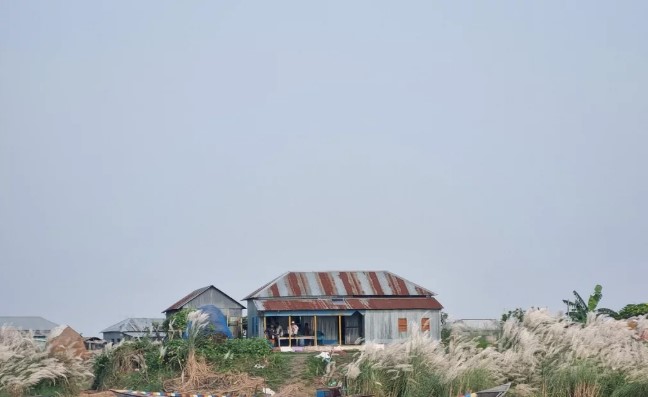Bangladesh’s climate refugees: A crisis rooted in colonial and policy failures
Climate displacement is no longer episodic but a permanent feature of our socio-environmental landscape , Nishat Tasnim [Publish : Dhaka tribune, 20 June 2025]

As a researcher working across erosion-prone chars (accreted river islands), urban slums, and faltering resettlement sites, I have witnessed a harrowing cycle: Families losing ancestral homes to rising rivers, then fleeing to cities like Dhaka, only to find themselves in tin-roofed settlements without secure work, water, or dignity.
This is not a random series of misfortunes. Rather, it is the outcome of preventable, systemic failures.
For too long, Bangladesh has treated displacement as a humanitarian emergency rather than a structural crisis shaped by colonial disruptions, broken adaptation policies, and underfunded resilience efforts.
In current times, if we are to reclaim mobility as a right, not a tragedy, this narrative must urgently change.
Echoes of displacement
Long before the colonial borders were drawn, the Bengal delta was shaped by climate-induced mobility. Prehistoric sea-level rise and centuries of river erosion forced communities inland, turning movement into survival.
By the late 19th century, life in riverine Bengal meant seasonal uprooting:
Villages shifting in response to chasing new alluvial land to farm, as the monsoon rivers fed on their land(s). These were not aimless migrations, but adaptive responses to ecological volatility.
Under British colonial rule, however, these rhythms were disrupted. Canal excavations and colonial cartographers drawing and redrawing our borders oftentimes fractured hydrological systems which intensified riverbank collapse and displaced tens of thousands.
As these early “delta drifters” gravitated to towns like Dhaka in the east and Kolkata in the west, they transformed urban peripheries by seeding today’s informal settlements.
In Bangladesh, slums are often viewed as modern crises but, in reality, they are rooted in layered histories of environmental displacement and contested development.
Hence, to understand today’s climate mobility, we must acknowledge that these historical patterns have morphed into a new frontier of displacement. One driven not by empire or war alone, but by escalating climate extremes
Partition, war, and new frontiers of today’s climate exodus
The upheavals from the partition in 1947 and the Liberation War in 1971 compounded this legacy of human mobility in Bengal - both historical events triggered waves of displacement amid political violence, floods, and creeping salinity.
Today, as per the latest Global Report on Internal Displacement (2025) over two million Bangladeshis are displaced annually by climate extremes. My fieldwork across chars, slums, and relocation sites reveals a bleak pattern: Nearly 70% of the displaced families who found refuge in informal urban settlements are devoid of adequate shelter and services; some even enter under-resourced resettlement schemes like Ashrayan Prakalpa, while others remain trapped in disaster-prone zones and caught in cycles of debt and malnutrition.
Several news outlets reported that in 2020, Cyclone Amphan forced two million into shelters, many of whom returned to find their homes ruined and land eroded due to salinity. In 2024, floods submerged 75% of Sylhet, while displacing thousands of families. In April this year, record-breaking heat waves pushed vulnerable populations to seek precarious coastal refuge.
It is clear to see that climate displacement is no longer episodic; it is a permanent feature of Bangladesh’s socio-environmental landscape.
The policy gaps fueling displacement
Despite Bangladesh’s celebrated resilience, critical policy shortcomings perpetuate these cycles of uprooting. Existing resettlement programs often view displaced families as passive victims rather than empowered partners in adaptation.
Also, secondary cities like Mongla and Khulna are straining under the pressure of new migrants, who already were grappling with water scarcity, vanishing green spaces, and overcrowded housing.
It is also worrisome that climate finance remains woefully inadequate. According to the United Nations Development Program (UNDP) finance report, published at the beginning of this year, Bangladesh requires an estimated $26 billion annually to build climate resilience but currently spends just over $2.8 billion, while multilateral funds are mired in bureaucratic delays. Meanwhile, displacement costs escalate, further entrenching vulnerability.
Breaking the cycle with a rights-based approach
Bangladesh stands on the frontlines of climate-induced displacement, where rising seas and riverbank erosion is uprooting millions annually. However, our history is one of ingenuity and adaptation and not of victimhood.
To transform displacement from coerced survival into voluntary choice, we must integrate displacement planning into national development strategies, connect climate-stressed rural areas to resilient secondary cities, guarantee secure land tenure, and scale up local livelihoods. Bangladesh can also lead a regional compact on climate displacement while establishing a “National Climate Resilience Bank” to streamline adaptation investments and innovative finance.
As the world convenes at the 30th Conference of the Parties (COP30), Bangladesh’s lived experience offers a vital lesson: Climate displacement is not an inevitability but a policy failure. With rights-based, forward-looking solutions, we can rewrite this story with dignity and justice.
Nishat Tasnim is a Research Officer at the International Centre for Climate Change and Development (ICCCAD). Email: nishat.tasnim@icccad.org.